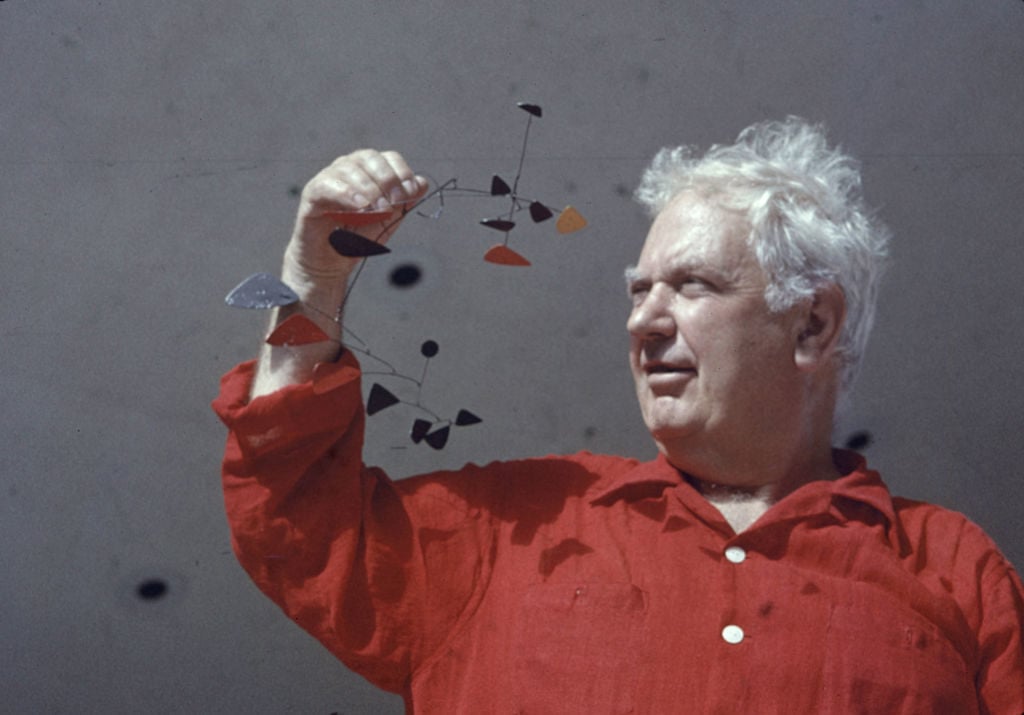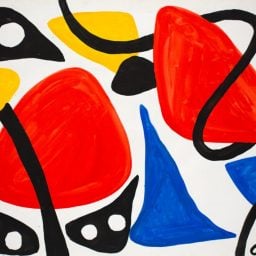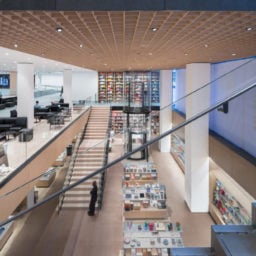Alexander Calder was one of the greatest American artists of the modern era. What follows is an excerpt from Calder: The Conquest of Space: The Later Years: 1940-1976, the second volume of his definitive biography by Jed Perl.
It’s impossible to overestimate the significance for Calder of the retrospective of his work that opened at the Museum of Modern Art on September 29, 1943. He certainly felt that way. In a letter to Alfred H. Barr Jr., written nearly a quarter century later, as Barr was preparing to retire from the museum, Calder said, “I have long felt that whatever my success has been has been greatly as a result of the show I had at the MoMA in 1943.” The exhibition brought together about 100 works. They ranged from a tiny sculpture of a dog that Calder had made of sheet brass when he was 11 or so to a group of about half a dozen of the Constellations that he had exhibited at the Pierre Matisse Gallery the previous spring. The Modern, which after a decade in various temporary locations had four years earlier moved into a new, capacious International Style building on West 53rd Street, was the most elegantly inviting museum in the world. Set in the midst of Manhattan’s hurly-burly, the museum suggested to one visitor, a curator from Great Britain, “an air of breathless, imaginative prophecy of cultural worlds to come.” With modern art in retreat all across war-torn Europe, the Modern looked like the last best hope for the creative revolution that had begun with the Postimpressionists in the last quarter of the nineteenth century. In the fall and winter of 1943, Alexander Calder was front and center, the keeper of the flame. His retrospective took up the entire ground floor and flowed into the sculpture garden.
Visitors arriving at the show were confronted with Calder’s work almost from the moment they came through the front door. The long lobby hallway that ran through the museum to doors opening onto the garden was filled with a selection of his larger recent works. Turning to the right off that entrance hall, museumgoers found themselves in a gallery lined with early wood and wire pieces and toys. Next came a gallery devoted to work from the early 1930s. Then, in the long room with glass walls facing the garden, there was a generous display of works from the mid-1930s to the present, with some larger objects, including Steel Fish and The Spider, displayed out of doors. Museumgoers were free to engage with Calder’s kinetic objects, whether by blowing on a mobile hanging from the ceiling or giving a shove to one or another element that was within reach. “Do not touch,” the assumption in just about every gallery and museum in the world, didn’t apply to this Calder retrospective at the Modern. In the garden, there was actually a sign posted that read “Please Touch.” In an essay published the year after the show, Mário Pedrosa, the Brazilian art critic with whom Calder became good friends, was amazed that “anyone could touch them, move them, sway them and even push them with their feet; in particular the large free moving mobiles.” He was “surprised” at what he referred to as an “overwhelming absence of taboos.”
This unfettered access to the kinetic possibilities of Calder’s work was pretty much taken for granted in galleries and museums until the mid-1960s. The artist was allowing his admirers to test the limits of traditional museumgoing behavior, much as he had tested the limits of traditional three-dimensional art when he made sculpture move. But the free give-and-take between the art and the audience couldn’t go on forever. After the battering and bashing that the artist’s legions of admirers gave the sculptures on display in a huge retrospective at the Guggenheim Museum in New York in 1964, there was no alternative but to put the old do-not-touch policy back in place. That has remained pretty much the situation ever since.
[…]
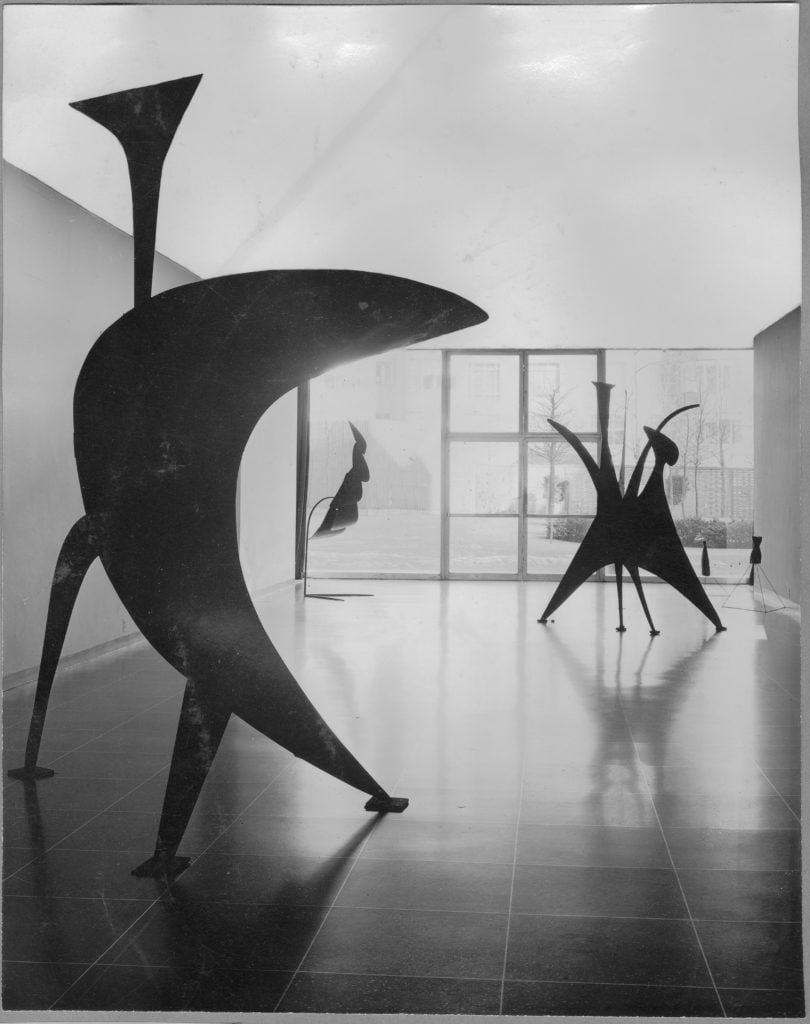
Installation view of Alexander Calder: Sculptures and Constructions. Photograph by the Museum of Modern Art, New York, 1943.
Calder threw himself into every aspect of the planning and execution of the show with his customary gusto—and then some. “I spent many days,” he later recalled, “like an ant, collecting my objects here and there and taking them to the museum. I know all the back roads of Connecticut, now.” There had never been a book or even a significant catalog dedicated to his work. Now he was going to change that. Although what was initially discussed was a catalog of only 32 pages, he managed to end up with something twice as big. [The exhibition’s organizer, James Johnson] Sweeney, who had a substantial income from a family import and export business with which he was at the time still deeply involved, told the Modern that he would contribute the $300 honorarium he was slated to receive for organizing the show toward the enlargement of the catalog. Then Calder, still eager for a bigger book, thought he might get what he wanted if he offered to give the museum a wooden horse that he had made in 1928 and that Barr apparently admired. “Do you think,” Sandy wrote to Sweeney, “we could bait that catalogue trap with horse-meat and offer them this in exchange for further expanding the catalogue[?]” However that conversation went, the Horse did end up in the Modern’s collection and Calder’s catalog as it finally appeared had 64 pages, much longer than originally planned, but still not as long as the Miró catalog two years before, which had 87. The catalog was illustrated with Matter’s beautiful photographs. Wheeler, using a photograph by [Herbert] Matter, devised a striking black-and-white dust jacket. “Monroe,” Calder wrote to Sweeney after he visited Matter’s studio, “wants the main part of the cover dark so that the book won’t get soiled in stores (a sales point)[.] I liked the idea of just white + black—it seems much strong[er].” For the endpapers, Matter employed a sheet of Calder’s little sketches of his works (complete with prices!) presented in negative, white lines on black ground; this was another nifty effect.
Sweeney’s catalog essay opened with broad, dramatic strokes. “Exuberance, buoyancy, vigor are characteristics of a young art,” he declared. He rapidly identified what he saw as the key characteristics of Calder’s art: his “humor,” his “dignity,” his “sensibility to materials that induces new forms,” and his “insatiable interest in fresh patterns of order.” Calder, as readers were made aware even before they had finished the first page of Sweeney’s text, was “a child of his own time,” at home in “the vernacular of his age in America—an age in which the frontiers of science, engineering and mechanics have dominated the popular imagination in the same way that the national frontier dominated it a century ago.” But how was an artist going to make art in such an age? The answer, Sweeney suggested, had more than a little to do with the artist’s sense of humor and sense of play. “Through humor,” he argued, “he satisfies the observer’s appetite for feeling or emotion without recourse to direct representation.” Humor became a form of purification. This was, Sweeney explained, “a humor that stirs up no specific associations and no emotional recollections to distract the observer’s attention from the work of art itself. Through this conscious infusion of a playful element, Calder has maintained an independence of the doctrinaire school of abstract art as well as of orthodox surrealism.”
To the end of his days, Calder cherished Sweeney’s text, which he regarded, along with the brief essay that Jean-Paul Sartre composed a few years later, as the best things ever written about his work. In his Autobiography, he praised Sweeney as “a stickler for the very finest language and correct facts.” He said he was “very grateful to Sweeney for this noble effort on my behalf. He is one of the very rare critics whom I can believe—probably the only one—and his book encouraged me, and many others, to believe I had something!” Those were strong words coming from Sandy Calder, a man who for all his high spirits was always parsimonious when it came to offering praise.
***
Sweeney had begun to write about Calder’s work a decade earlier, and he would still be writing about it after the artist’s death. What he alluded to but didn’t fully explore in the Modern catalog was the place of play in Calder’s art. He may intentionally have avoided any extended discussion, aware as he was that play was a highly charged word—and that if he wrote too much about it he might leave museumgoers with the impression that Calder was a lightweight at the very moment when the museum was honoring him as a heavyweight. Sweeney knew that if some people associated play with engagement, discipline, creativity, innovation, and adventure, there were plenty of others who associated it with escapism, lack of discipline, dilettantism, anarchy, and even nihilism.

Alexander Calder’s Cheval Rouge (Red Horse) on display in the National Gallery of Art Sculpture Garden in Washington, DC. Photo by Robert Alexander/Getty Images.
Calder’s way of jumping with both feet into anything he was doing sometimes left him open to the accusation that he was just fooling around. In 1949, when he made a mobile for Dorothy Miller, an important curator at the Modern whom he had gotten to know around the time of his retrospective, he appeared at her Greenwich Village apartment with his pliers and a suitcase full of wires and various biomorphic shapes. Although the mobile had probably been carefully planned well before Calder arrived in Miller’s apartment, as she told the story years later, she made it seem as if Sandy had gotten up on a stepladder and begun, on the spot, to fashion the mobile that for decades hung from an old chandelier knob in her ceiling. Among the other works by Calder that Miller owned was a magnificent brooch, with her initials wittily transformed into a spiral vortex. For Miller, one of the most sophisticated and influential curators of her time, the appearance in her apartment of the formidable mobile Red Ghost, with its nine elements in black, red, and yellow, was an act of imaginative genius—but to others it might have seemed nothing more than child’s play. Which brought anybody who cared to think about such things back to the whole question of play—and where play came from and what it meant to play.
It was more than a decade after the Modern retrospective had closed that Sweeney saluted Calder as “a lyricist in play.” He wrote that Calder valued a game because “it implies rules and further suggests a matching of contraries—of ‘sides’ in the common sports usage.” In an essay entitled “Alexander Calder . . . Work and Play,” he asserted that the basis of Calder’s sculpture was “a love of play.” “Play with Calder,” he argued, “is never frivolous. It is serious, but never solemn. Play is a necessity for Calder which he has to respect, to treat seriously.”30 With Calder the feeling for play and games, so Sweeney was suggesting, was expansive and optimistic, a vision of games not as psychological and inward-turning but as physical and outward- flowing. Calder had no use for the dark dreams of the Surrealists and the absurdist dramas of the Dadaists. His art was not a critique of reality but an engagement with reality. He saw play as strong, clear, and forceful— a responsibility to be joyously embraced. Sweeney—who had been one of the group of admirers assisting James Joyce, that sublime wordsmith, in the years when Finnegans Wake was being composed—understood as well as anybody that play as an idea and an ideal had been the lifeblood of the Euro- pean avant-garde. In 1925, the year before Calder arrived in Europe, Vladimir Nabokov, a man almost exactly Calder’s age, had declared in a lecture in Berlin that “everything good in life—love, nature, the arts, and family jests—is play. And when we actually play—whether we’re knocking down a tin battalion with a pea or drawing together across the net barrier in tennis— what we feel in our very muscles is the essence of that play which possesses the marvelous juggler, who tosses from hand to hand in an unbroken sparkling parabola… the planets of the universe.”
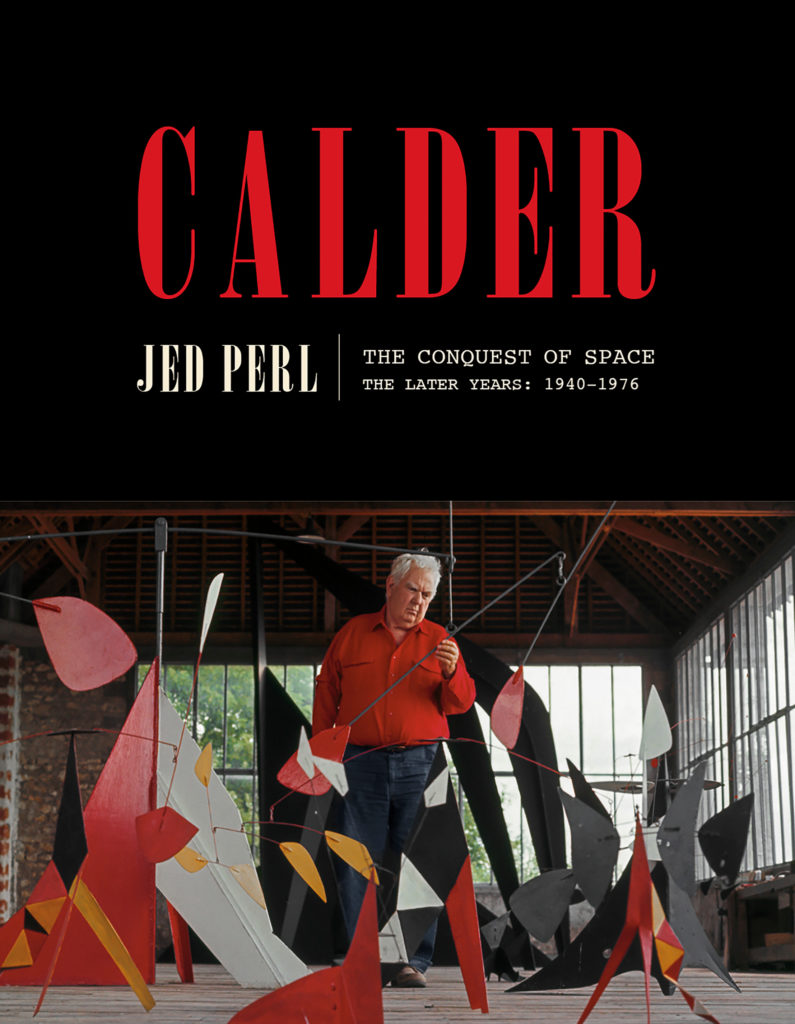
Visitors to the Modern retrospective in 1943 could see how Calder’s sense of play had evolved. Some of the first kinetic works had been driven by a motor or a crank; museumgoers were presented with a preordained, generally very slow-moving pattern of play. Then, in the year or so before Sandy and Louisa returned to the United States in 1933, Calder began to offer gallerygoers an element of choice; he was urging them to join in the games. He created at least one sculpture, Object with Red Ball (1931), in which the relationship of the elements was actually adjusted by the viewer; the red ball could be moved along the horizontal white dowel from which it hung, and the rod itself could be moved into different positions.33 Almost simultaneously he was developing what might be called the hand-driven mobile—Cône d’ébène, done just before the return to the United States, was a good example. He was inviting a viewer to initiate the movement, to activate forces by giving one of the elements a little shove. But soon after moving back to the United States and settling in western Connecticut, Calder began to allow—one might almost say encourage—his mobiles to take on a life of their own. He found himself focusing on wind-driven works. He was celebrating the more mysterious play of forces that nature itself imposed on the elements that he orchestrated. The mobiles of his high classical period are freedom incarnate. They play by themselves—they turn, they twist, they expand, they contract, they reveal an order that is within or beyond the order that the artist has created.
Excerpted from Calder: The Conquest of Space: The Later Years: 1940-1976 by Jed Perl. Copyright © 2020 by Jed Perl. Excerpted by permission of Alfred A. Knopf, a division of Penguin Random House LLC. All rights reserved. No part of this excerpt may be reproduced or reprinted without permission in writing from the publisher.
